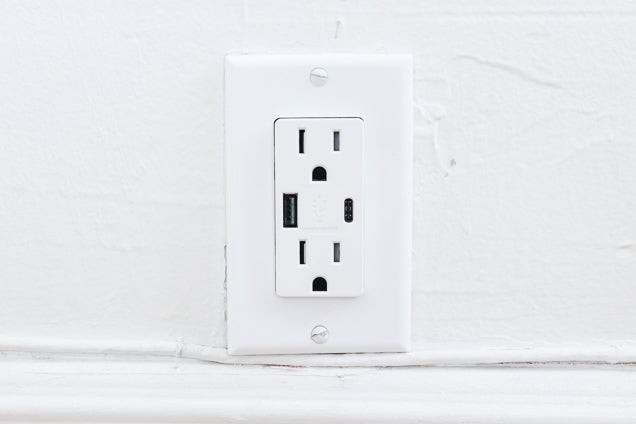Traveling the globe is an incredible adventure, filled with new sights, sounds, and experiences. However, navigating different electrical systems can quickly turn your dream trip into a frustrating scramble for power. Imagine arriving at your hotel after a long flight, only to realize your phone charger doesn’t fit the wall outlet. This is where the humble travel adapter becomes your indispensable travel companion.
Whether you’re a seasoned globetrotter or planning your first international trip, understanding travel adapters is crucial for keeping your devices charged and ready. From smartphones and laptops to cameras and essential travel gadgets, staying powered up is no longer a luxury – it’s a necessity. This guide will demystify travel adapters, helping you choose the right one and ensuring you remain connected wherever your adventures take you.
 A front look at a wall outlet with two standard plugs in addition to a USB-A and USB-C port.
A front look at a wall outlet with two standard plugs in addition to a USB-A and USB-C port.
Modern wall outlet featuring USB ports alongside standard plug sockets, illustrating the evolving landscape of charging solutions.
Universal Travel Adapter vs. Simple Plug Adapter: Which is Right for You?
When it comes to travel adapters, you’ll primarily encounter two main types: universal travel adapters and simple plug adapters. Each offers distinct advantages and disadvantages, catering to different travel styles and needs.
Universal Travel Adapters: The All-in-One Solution
Universal travel adapters are designed for maximum convenience. These ingenious devices consolidate multiple plug types into a single unit, often featuring retractable prongs that adapt to various outlet configurations around the world. Many modern universal adapters also incorporate USB ports, eliminating the need for separate USB chargers for your phones, tablets, and other USB-powered devices.
Pros:
- Versatility: One adapter for (almost) every country. Ideal for frequent international travelers or multi-destination trips.
- Convenience: Reduces clutter by combining multiple adapters into one device.
- USB Charging: Integrated USB ports minimize the need for extra chargers.
Cons:
- Bulkier: Larger and heavier than simple plug adapters, taking up more luggage space.
- Potential Fragility: Moving parts can be more prone to breakage compared to simpler designs.
- Slower Charging (Potentially): Some universal adapters might charge devices slightly slower than dedicated USB wall chargers.
- Not Truly Universal: Despite the name, they may not work in every single country or with every outlet type (more on this later).
Simple Plug Adapters: Compact and Specialized
Simple plug adapters are smaller, more basic devices. They consist of a single plug type conversion, designed to adapt the prongs of your existing chargers to fit specific foreign outlets. Often sold in sets, they are a cost-effective and space-saving solution for travelers visiting specific regions.
Pros:
- Compact and Lightweight: Minimal bulk and weight, ideal for minimalist packers.
- Reliable and Durable: Fewer moving parts mean less chance of malfunction.
- Faster Charging (Potentially): Using your device’s original charger with a simple adapter usually ensures optimal charging speed.
- Essential for Specific Outlets: Necessary for countries with outlet types not covered by universal adapters.
Cons:
- Less Versatile: Each adapter works only in specific regions. Requires carrying multiple adapters for multi-country trips.
- No USB Ports: Does not eliminate the need for separate USB chargers.
- Requires Existing Chargers: Assumes you already have USB wall chargers or device-specific chargers.
Making the Right Choice: Universal vs. Simple
The choice between a universal travel adapter and simple plug adapters boils down to your individual travel needs and preferences.
- Choose a Universal Travel Adapter if: You are a frequent international traveler, visiting multiple countries with different outlet types, and prioritize convenience and all-in-one functionality.
- Choose Simple Plug Adapters if: You are traveling to a specific country or region with known outlet types, value compactness and reliability, and prefer using your existing chargers.
Consider your typical travel style. If you’re a minimalist backpacker hopping across continents, a universal adapter might be your best bet. If you’re on a business trip to a single European country, a set of European plug adapters might suffice.
Navigating the World of Outlet Types: Where Will Your Adapter Work?
Universal travel adapters typically incorporate four main plug types, designed to cover the most commonly visited destinations for travelers from the US and similar regions. These usually include:
- Type G (UK-style): Characterized by three rectangular prongs. Used in the United Kingdom, Ireland, Hong Kong, Singapore, and parts of the Middle East and Asia.
- Type C (Europlug): Features two round pins. Common throughout most of Europe, as well as parts of Asia and South America. However, variations exist within Europe (e.g., Italy, Switzerland, Denmark).
- Type I (Australian-style): Two or three flat angled blades. Used in Australia, New Zealand, China, Argentina, and parts of Oceania.
- Type A/B (US-style): Two flat prongs (Type A) or two flat prongs with a grounding pin (Type B). Used in North America, Japan, and parts of Central and South America.
An older Italian-style wall outlet, highlighting the potential for encountering less common socket types even in popular travel destinations.
However, the world is electrically diverse. Many countries utilize outlet types not included in standard universal adapters. Examples include:
- Type L (Italy): Three round pins in a line.
- Type N (Brazil): Two round pins and a grounding pin, but in a different configuration than Type C.
- Type M (South Africa): Large, rounded pins in a triangular configuration.
- Type D (India): Three large round pins in a triangular configuration (older standard, Type M is also used).
To determine the plug types used in your destination, consult resources like the IEC World Plugs website or the Wikipedia article “Mains electricity by country“. Always check before you travel, especially if visiting less common tourist destinations or older buildings, which may have outdated outlet types.
Do You Need a Voltage Converter? Understanding Voltage vs. Plug Adapters
It’s crucial to distinguish between plug adapters and voltage converters. Plug adapters simply change the shape of the plug to fit into a different outlet. They do not change the electrical voltage.
Most modern electronic devices, particularly chargers for phones, laptops, and tablets, are designed to handle a wide voltage range (typically 100-240V). This is often indicated on the charger itself, usually printed near the input specifications. These devices are dual-voltage and only require a plug adapter to physically fit into the outlet.
However, some older or high-power appliances like hair dryers, curling irons, or certain electronics may be designed for a specific voltage (e.g., 110V for US standard). If you intend to use these in a country with a higher voltage (e.g., 220V in Europe), you will need a voltage converter in addition to a plug adapter to prevent damage to your device.
As a general rule:
- For most travel electronics (phones, laptops, tablets, USB devices): You only need a travel adapter. Check the voltage input on your charger to confirm it supports 100-240V.
- For high-power appliances or devices with specific voltage requirements: You may need a voltage converter in addition to a travel adapter. Carefully check the voltage requirements of your device and the voltage of your destination country. It’s often safer and more practical to use dual-voltage travel appliances or purchase them at your destination.
Power Up Your Adventures: Travel Adapter Essentials
A travel adapter is more than just a travel accessory; it’s an essential tool for staying connected and powered up on your global explorations. By understanding the different types of adapters, outlet configurations, and voltage considerations, you can confidently choose the right adapter for your journey and ensure your devices are always ready for your next adventure. Don’t let incompatible outlets interrupt your travels – pack a travel adapter and explore the world with power at your fingertips.
